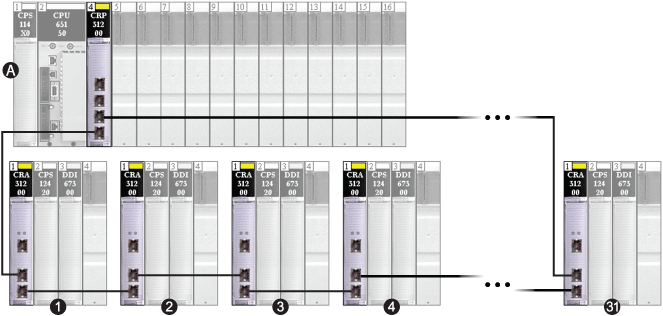Application response time (ART) is the time a application requires to react to a single input. ART starts when an input signal turns ON and triggers a write command by the PLC, and ends when the remote output turns ON to signify that the data has been received. Each Ethernet remote I/O packet travels from an Ethernet to the PLC (input) then back to the Ethernet remote I/O drop (output). In a Quantum EIO system, the ART is , which means you can calculate the maximum time the PLC uses to resolve a remote I/O logic scan.
Overview: ART Computation Parameters
NOTE:
Overhead in the previous illustration refers to the time period between the end of MAST processing (noted by the end of out) and the start of the next period (based on PLC MAST cycle time).
|
A: missed input scan
|
7: packet held in CRP queue (1 scan)
|
|
B: missed output scan
|
8: operation of application logic (1 scan)
|
|
1: input turns ON
|
9: CRP output jitter
|
|
2: CRA drop process time
|
10: network output time
|
|
3: CRA input Request Packet Interval () rate
|
11: network output jitter
|
|
4: network input time
|
12: CRA drop process time
|
|
5: network input jitter
|
13: output applied
|
|
6: CRP input jitter
|
A Quick Estimation of ART
You can estimate the maximum ART — based on the maximum number of distributed I/O and remote I/O devices — for an application, by summing the following values:
Note that the constant value — 32.596 — applies to any combination of remote I/O and distributed I/O
network topologies.
NOTE: If a cable break occurs or a cable is reconnected on the network, add an additional time period to the above ART calculation to allow for RSTP recovery. The additional time to be added equals: 50ms + RPI.
A Simplified Computation of ART for Simple Daisy Chain Loop of 140CRA31200 Modules in a Remote I/O Main Ring
This example calculates the ART from the perspective of the 140CRA31200 adapter that is the last of 31 adapters in a simple remote I/O daisy chain loop, as depicted below:
A
local rack
1, 2, 3, 4...31
simple daisy chain loop of 31 adapters
In this example, ART is calculated from the perspective of the last, or 31st, adapter in the daisy-chain loop.
Recall that the formula to estimate the maximum ART is:
ART= RPI + (2*CPU_Scan) + 32.596 ms
Thus, for a CPU scan time of 40 ms and RPI of 25 ms, maximum ART is:
max ART = 25 + (2*40) + 32.596 = 137.596 ms
NOTE: If a cable break exists on the network, add an additional time period — equal to 50 ms + RPI — to the above ART calculation. The added time allows for RSTP recovery from the cable break.

